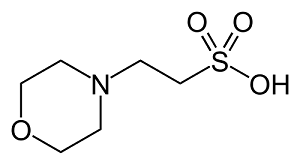MES (buffering agent)

Product Description
4-Morpholineethanesulfonic acid, also known as MES, is a commonly used buffering agent in biochemical and molecular biology laboratories.
Product:
MES (buffering agent)
CAS:
4432-31-9
Synonym:
4-Morpholineethanesulfonic acid; 2-(N-Morpholino)ethanesulfonic acid
Structure:

Typical Characteristics
Appearance
White powder
Density
1.208 g/cm3
Melting point
>300 °C (decomposes)
Molecular Weight
195.24
Purity
≥99%
Refractive index
1.5500
Uses, Applications & Markets
Key applications
Markets
get a quote
We Offer MES (buffering agent)
in various grades
A few of the grades available are listed below:



MES (buffering agent) used in many
industry applications
4-Morpholineethanesulfonic acid, also known as MES, is a commonly used buffering agent in biochemical and molecular biology laboratories. Here are some of its uses:
- Buffering Agent: MES buffer is widely used as a buffering agent in various biological and biochemical assays, particularly those involving enzymatic reactions and cell culture. It helps maintain a stable pH environment, typically around pH 6.0 to 7.2, which is suitable for many biological processes.
- Electrophoresis: MES buffer is used in electrophoresis techniques such as SDS-PAGE (sodium dodecyl sulfate polyacrylamide gel electrophoresis) and native PAGE. It provides the appropriate pH conditions for separating and analyzing proteins and nucleic acids based on their size and charge.
- Cell Culture: MES buffer is employed in cell culture media to maintain the pH of the medium within the physiological range. It helps stabilize the pH despite changes in carbon dioxide levels and metabolic activity, providing a consistent environment for cell growth and proliferation.
- Enzyme Kinetics: MES buffer is used in enzyme kinetics studies to control the pH of reaction mixtures. It ensures that the enzymatic reactions occur under optimal conditions, allowing researchers to accurately measure enzyme activity and kinetics parameters.
- Biophysical Studies: MES buffer is utilized in various biophysical studies, including spectroscopy, calorimetry, and protein crystallization. It provides a stable pH environment that minimizes interference with the interactions and properties of biomolecules under investigation.
- Analytical Chemistry: MES buffer may be used in analytical chemistry techniques such as liquid chromatography and capillary electrophoresis. It helps maintain the pH of mobile phases and separation buffers, ensuring reproducible and reliable results in chemical analysis.
- Quality Control: MES buffer is used as a component of quality control procedures in laboratories to standardize experimental conditions and ensure the accuracy and reproducibility of experimental results across different assays and experiments.